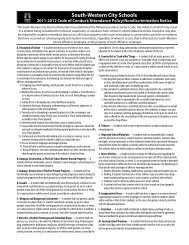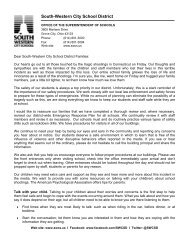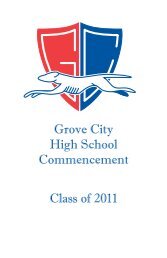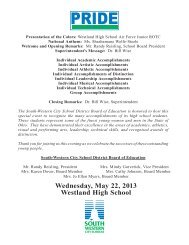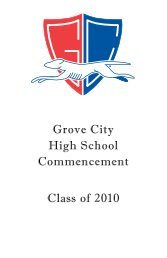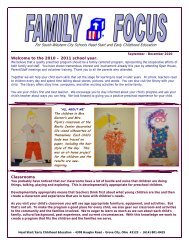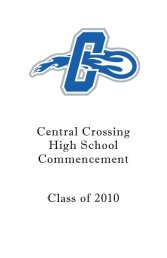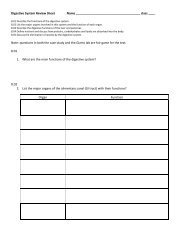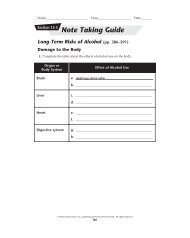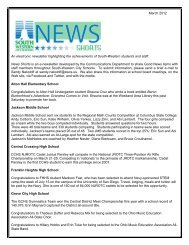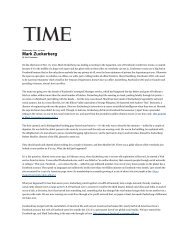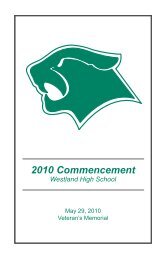7th - compare-contrast
7th - compare-contrast
7th - compare-contrast
Create successful ePaper yourself
Turn your PDF publications into a flip-book with our unique Google optimized e-Paper software.
<strong>7th</strong> Grade<br />
Compare/Contrast<br />
Heading<br />
• Compare the treatment, scope and<br />
organization of ideas from<br />
different texts on the same topic<br />
• Compare and <strong>contrast</strong> different<br />
sources of information, including<br />
books, magazines, newspapers<br />
and online resources, to draw<br />
conclusions about a topic<br />
• Make critical comparisons across<br />
text, noting author’s style as well<br />
as literal and implied content of<br />
text
Comparing and Contrasting<br />
When students <strong>compare</strong> and <strong>contrast</strong>, they are finding similarities and differences<br />
in what they are reading. Help students understand the concept of comparing and<br />
<strong>contrast</strong>ing by making analogies to synonyms and antonyms, how things are alike<br />
and how they are different and identifying similarities and differences.<br />
Some nonfiction text is organized used a <strong>compare</strong>/<strong>contrast</strong> framework. In this type<br />
of writing, a writer <strong>compare</strong>s two ideas, events, or phenomena, showing how they<br />
are similar and different. The writer states the issues or concepts being <strong>compare</strong>d<br />
and explains them in enough detail to help the reader understand why the comparison<br />
is significant. Within the text the writers use description as well as comparison/<strong>contrast</strong><br />
to make points. There are some words that often signal such a<br />
text:<br />
• while<br />
• yet<br />
• but<br />
• rather<br />
• either<br />
• like and unlike<br />
• some<br />
• as opposed to<br />
• as well as<br />
• on the other hand<br />
• although<br />
• the same<br />
• similarly<br />
In Effective Reading Strategies Rasinski and Padak state “One important aspect of<br />
comprehension is the ability to make thoughtful comparisons across texts, between<br />
events within stories, and across other aspects of stories that students read. For<br />
many students making comparisons can be a daunting task, and neither textbooks<br />
nor teachers always explain the process sufficiently.” If this is true, then we must<br />
work even harder at providing those sufficient explanations.<br />
Fountas and Pinnell say, “Help students <strong>compare</strong> texts. Students are often expected<br />
to respond to a series of questions that require reading several different<br />
texts, sometimes of different genres. Because your students are reading many different<br />
texts in guided reading, literature study and independent reading, you can<br />
easily guide them to <strong>compare</strong> and <strong>contrast</strong> those texts. They can <strong>compare</strong> characters’<br />
appearance, actions, motives, points of view, and so forth; plots or events; and<br />
settings. They can <strong>compare</strong> fiction, nonfiction and poetic texts on the same topic or<br />
with the same setting (geographical or historical). Comparing texts helps them<br />
delve into the deeper meaning of complex concepts such as “heroism” or “voyages.”
Suggested<br />
Strategies for<br />
Teaching<br />
Compare/Contrast
Compare and Contrast Game<br />
Write the names of a variety of objects on small cards. Pairs of students should<br />
pick two cards, then fill in a Venn diagram identifying ways in which the objects are alike<br />
and different. When they have finished, they should share the likenesses and differences<br />
with other members of the class without identifying the objects. Students should infer<br />
from the clues to determine what two objects are being <strong>compare</strong>d.<br />
Example: pencil, computer<br />
Pencil<br />
Computer<br />
wooden used to write keyboard<br />
sharp point words uses electricity<br />
rubber eraser can be erased programmable<br />
needs power<br />
Sample Objects to Compare:<br />
Horse, bus, umbrella, banana, purse, potato chip bag,<br />
cloud, eagle, pencil, computer, paper, cow, desk, mug,<br />
clock, tape, calculator, phone, bookshelf, bobsled, ocean,<br />
diamond, spaghetti, photograph, violin, rope, plate, laundry,<br />
litter, window, lion, moon, magazine<br />
Compare and Contrast Signal Words<br />
Teach students that there are certain words that usually indicate a need to <strong>compare</strong> or <strong>contrast</strong><br />
information. When they see these words, they should know what they are expected to do. In addition,<br />
the wording in questions addressing these skills does not vary a great deal.<br />
Compare Signal Words:<br />
• All<br />
• As well as<br />
• At the same time<br />
• Both<br />
• Like<br />
• Same as<br />
• Similarly, similar to<br />
Compare Questions:<br />
• How are ___ and ___ alike?<br />
• What is the same about ___ and ___ ?<br />
• Compare ___ and ___.<br />
• How was ___ like ___?<br />
Contrast Signal Words:<br />
• Although<br />
• As opposed to<br />
• Compared with<br />
• Different from<br />
• Either . . . Or<br />
• However<br />
• Nevertheless<br />
• Not only . . . But<br />
• Though<br />
• Unlike<br />
Contrast Questions:<br />
• What are the differences between ___ and<br />
___?<br />
• How is a ___ different from a ___?<br />
Compare/Contrast text structure requires the reader to be a shopper — looking for what’s the same<br />
and what’s different, then making decisions based on those observations.
Venn Diagrams<br />
Venn diagrams are perhaps one of the best graphic organizers to use<br />
in helping students learn to <strong>compare</strong> and <strong>contrast</strong> information. When beginning<br />
to use Venn diagrams, determine first of all what two things you want to<br />
<strong>compare</strong>. It might be two versions of a story, two characters found in the<br />
same story, or changes in a character from the beginning to the end of a<br />
story.<br />
Model for the students how to complete a Venn diagram to <strong>compare</strong><br />
and <strong>contrast</strong>, explicitly talking about the types of information that go in the<br />
circles and the intersection of the circles. Then guide students through the<br />
process by having them tell you information to put on the Venn diagram.<br />
Eventually, your goal is that students can complete a Venn diagram on their<br />
own, placing information in the correct places. This final step is one that is<br />
often omitted. Teachers commonly use Venn diagrams to <strong>compare</strong> and <strong>contrast</strong>,<br />
but students many times have no experience creating one by themselves.<br />
Use Venn Diagrams<br />
to Compare:<br />
• A character before and<br />
after an event in his/<br />
her life<br />
• Two different novels<br />
with the same theme<br />
• A short story and a<br />
novel<br />
• Student’s lif e to that of<br />
a character in a book<br />
• Time period of a novel<br />
to pre sent-day times<br />
T-Charts and Double Entry Journals<br />
T-charts are another common graphic organizer used to help students learn to <strong>compare</strong><br />
and <strong>contrast</strong> elements of fiction. T-charts have been found more than once on proficiency tests.<br />
These charts have <strong>compare</strong>/<strong>contrast</strong> questions at the top of each column, and the students are<br />
asked to supply answers to the questions in each column. Typical questions might be “How are<br />
Mary and John alike?” and “How are Mary and John different?”<br />
Other types of T-charts might simply be labeled with characters’ names, names of places,<br />
or titles of stories. Students are then asked to make notes about the selection under the correct<br />
headings.<br />
Just Like<br />
Readers select a character from a book and list traits of that character in the first column.<br />
For each trait, readers need to read across the columns to decide if they also<br />
have that trait (column 2), if someone they know has that trait (column 3), or if another<br />
character has that trait. A Just Like form is included in this handbook.
Just Like<br />
Book ________________________________________________________________<br />
The Character ________________________________________________________<br />
Character traits Like myself? Like a friend? Like another<br />
character?
Feature Matrix<br />
A feature matrix is a table that allows students to <strong>compare</strong> the characteristics<br />
of several different things. Since it contains information that has been organized<br />
into categories, it is a quick way to interpret a large quantity of data and<br />
see patterns of similarity and difference.<br />
1. Label the matrix at the top of the page<br />
2. Identify the things or objects to be <strong>compare</strong>d and write them in the column<br />
down the left side of the template.<br />
3. Note the characteristics to be <strong>compare</strong>d and write each in one of the rows<br />
across the top of the template.<br />
4. Determine whether each object listed in the column has any of the characteristics<br />
listed in the rows, and if there is a match, place an X in the<br />
box.<br />
5. Continue to evaluate and mark each object in the column.<br />
6. Look for similarities by noting patterns of X’s and look for differences<br />
by noting blank boxes.<br />
Encourage students to discuss similarities and differences and draw conclusions.<br />
c<br />
a<br />
t<br />
d<br />
o<br />
g<br />
c<br />
o<br />
w<br />
s<br />
n<br />
a<br />
il<br />
l<br />
a<br />
m<br />
b<br />
fi<br />
s<br />
h<br />
h<br />
o<br />
r<br />
s<br />
e<br />
a<br />
p<br />
e<br />
legs x x x x x x<br />
fur x x x x x x<br />
shell<br />
fins<br />
pet<br />
live<br />
in<br />
water<br />
x<br />
x<br />
x x x x x x x x<br />
walk x x x x x x<br />
x<br />
x<br />
Same or Different Book<br />
Select a familiar story for which there are several versions. Fairy tales work well for this<br />
activity. Students create a book that illustrates how the versions are either alike or different.<br />
Follow these steps to make the book:<br />
• Divide the paper into halves, labeling each half with one of the book titles<br />
• If students are making a “different” book, they draw a picture of something that is different in<br />
each of the stories<br />
• If they are making a “same” book, they draw a picture of something that was the same in<br />
each of the stories<br />
• Students may include as many pages as they like, or you may suggest topics for the pages<br />
such as characters, setting, problem, etc.
Feature Matrix
Character Charts<br />
When analyzing characters, students are often taught to look at their physical appearance, their actions,<br />
their feelings, and the reactions of other characters to them. By closely examining these , aspects<br />
of characters, students can make inferences about them. If you want students to <strong>compare</strong><br />
characters to each other, create a chart that leads students to examine multiple aspects of<br />
each of the characters. This chart might look like the one pictured below:<br />
Character<br />
Sarah<br />
John<br />
Carrie<br />
Physical<br />
Appearance<br />
Actions Feelings Reaction of<br />
Others<br />
After students complete the chart, have them write comparisons of the<br />
characters using information from the chart.<br />
Other Headings for<br />
Comparison Charts<br />
● Characters<br />
● Setting<br />
● Illustrations<br />
● Language<br />
● Problem<br />
● Resolution<br />
Write about Comparisons/Contrasts<br />
Many students learn through writing. Following are some possible writing topics to help students<br />
learn to <strong>compare</strong> and <strong>contrast</strong>:<br />
• Rewrite a story, changing the setting. Students must think about whether the original setting<br />
worked for the plot and theme. In making the change, they will have to consider how the new setting<br />
affects these and other aspects of the story and will have to accommodate accordingly.<br />
• Strengthen students’ understanding of how point of view shapes a story by asking them to tell the<br />
story from a viewpoint of a different character.<br />
• Changing the beginning or ending of a story or adding another episode to the story will give students<br />
an opportunity to grapple first hand with aspects of plot.<br />
• If a story goes back and forth in time, have students tell the story sequentially. This will help them<br />
see that flashbacks are an effective literary mechanism.<br />
• Rewrite a story as a folktale or fairy tale, change poetry to prose, or make a short story into a play.<br />
These activities will give students insights into different genres.<br />
• Change adjectives and/or the formality of the language to help students see how these changes<br />
can alter the mood of a story.<br />
• Students can learn about author‘s style by modeling the writing of a story after a particular book.<br />
Pattern books work well for this activity.<br />
• Encourage students to practice using similes, metaphors, personification, irony, hyperbole and understatements<br />
so they will have a better understanding of these literary devices when they are<br />
reading.
Character Comparison<br />
Character Physical<br />
Appearance<br />
Actions Feelings Reaction of<br />
Others
Story Map Showing Character Change<br />
The graphic organizer shown below can be used to help students understand the change in a character<br />
from the beginning to the end of a story.<br />
Turning Point<br />
Character at Beginning of Story Events that Caused Change Character at End of Story<br />
More Ways to Examine Characters<br />
Try one or more of the following to help students <strong>compare</strong>/<strong>contrast</strong> characters they encounter while<br />
reading:<br />
• Make a progressive list of words/phrases to describe a character while reading a story. Examine<br />
the list to determine how the character has changed throughout the story.<br />
• Write a description of a character, a feeling about a character or an opinion of a character at the<br />
beginning of reading a book. Then write the same when the book is finished. Compare the two<br />
and tell how the character has changed and how your feelings about the character have<br />
changed.<br />
• Make a timeline of a character’s life or development as a story progresses.<br />
Comparing Setting<br />
Following are some activities to use when working on comparing and <strong>contrast</strong>ing settings:<br />
• Present the setting visually as a map showing a journey, a grid map or pictures built up progressively<br />
as the story is read, a travel brochure or poster, or a class mural, collage or montage.<br />
• Describe a setting from different viewpoints.<br />
• Discuss descriptive passages to see how a writer has made them vivid, then encourage students<br />
to use the same devices in their writing.<br />
• Make progressive charts of descriptive words to use later as the basis for writing.
Changes in Characters<br />
Character at Beginning of<br />
Story<br />
Events That Caused Change Character at End of Story
Story Comparisons<br />
Title:<br />
Title:<br />
Setting<br />
Setting<br />
Time Period<br />
Time Period<br />
Conflicts<br />
Conflicts<br />
Resolution<br />
Resolution<br />
Development of Main Character<br />
Development of Main Character<br />
Challenges<br />
Challenges
Theme Study<br />
Have students read a variety of books centered on the same theme. Create a class chart<br />
that summarizes the main points of each story. Lists of words used to describe similar characters<br />
might also be listed on the chart. These can help in defining relationships among characters in the<br />
books.<br />
Summarize the theme study by asking questions similar to the following:<br />
• What is the author’s intention?<br />
• What have we learned about . . . that we didn’t know before?<br />
• Which books remind us most of ourselves? How?<br />
• How do different people cope with . . .?<br />
• How can our “stereotypes” . . . be misleading?<br />
Character Sociogram<br />
Sociograms show the relationships of people to each other. Identify the major characters from a<br />
story that has been read and place their names in the circles on a sociogram similar to that pictured below.<br />
On the lines that connect the character names,<br />
write a brief statement that addresses the relationship<br />
of the two characters.<br />
Graphic Organizers<br />
to Help with<br />
Comparing and<br />
Contrasting<br />
(copies are included)<br />
● Story Comparison<br />
● One and All — to<br />
<strong>compare</strong> four items<br />
● Triangle-gram
One and All Organizer<br />
2<br />
1<br />
ALL<br />
3<br />
4
Triangle-gram<br />
A<br />
Similarities<br />
B
Position Paper<br />
Provide students with several articles on a specific topic that present two sides<br />
of an issue. Students should read the articles and take notes on points made<br />
by both sides. With a partner, they should then pick a side and write a position<br />
paper defending their position with factual evidence. Students can also<br />
participate in trials or debates on controversial issues. For a more advanced<br />
version of this activity, have students pretend they are senators and cast ballots<br />
either for or against a particular position.




